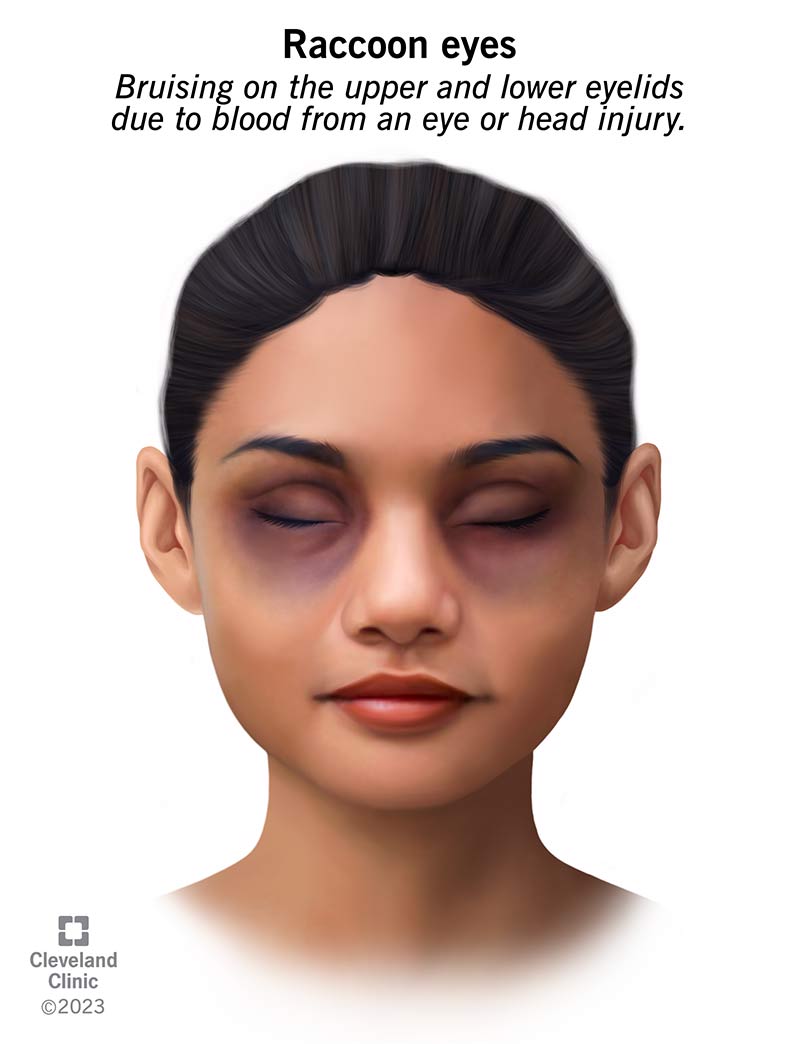Raccoon eyes are bruises around your eyes where blood pools underneath your skin. The bruises are darker than your natural skin tone and are often blue to purple. It’s usually a sign of an injury, like a skull fracture. After an injury, it could take up to three days for them to appear and up to two weeks for them to clear up.
Advertisement
Cleveland Clinic is a non-profit academic medical center. Advertising on our site helps support our mission. We do not endorse non-Cleveland Clinic products or services. Policy

Raccoon eyes, also known as the raccoon sign, are dark blue to purple bruises on your upper and lower eyelids. It makes it look like you have two black eyes. These happen when blood leaks into your eyelid tissue (periorbital tissue), usually after an eye or head injury. The condition gets its name from the dark fur around a raccoon’s eyes since the raccoon sign resembles this.
Advertisement
Cleveland Clinic is a non-profit academic medical center. Advertising on our site helps support our mission. We do not endorse non-Cleveland Clinic products or services. Policy
You may hear your healthcare provider refer to raccoon eyes or the raccoon sign as periorbital ecchymosis, which means bruising around the eyes.
If you experience raccoon eyes, talk to a healthcare provider. It may be a sign of an underlying medical condition or a serious injury. Not all cases are severe, but it isn’t safe to risk going without a diagnosis. This is because some causes of raccoon eyes may be life-threatening if left untreated. A healthcare provider will determine the underlying cause and advise you on a treatment plan, if necessary.
You may notice dark circles under your eyes if you didn’t get enough sleep the night before. These aren’t the same as raccoon eyes. Raccoon eyes are bruises around your eyes (top and bottom). Dark circles don’t involve bruising and only cause slight darkening of the skin underneath your eyes. Raccoon eyes are the result of blood in the tissue surrounding your eye, especially after an injury. Dark circles aren’t a cause for concern and could happen due to age, genetics and fatigue.
An injury is the most common cause of raccoon eyes. Broken blood vessels (capillaries) cause blood to pool beneath the skin around your eyes. It doesn’t take much to break these blood vessels since they’re delicate. An injury could be minor, like irritation after plucking your eyebrows, or as severe as a skull fracture.
Advertisement
Common injuries that cause raccoon eyes include:
Most fractures and injuries happen after an accident with blunt force trauma, like a vehicle crash, for example. You don’t get raccoon eyes immediately after an injury. You might notice the sign one to three days after the event.
In addition, you may experience raccoon eyes after a cosmetic or facial surgery like rhinoplasty or other medical procedures.
The following medical conditions can also lead to raccoon eyes:
Raccoon eyes may be a warning sign of pressure in your skull around your brain (intracranial hypertension). It can also be a warning sign that you’re leaking brain fluid and could be at risk for a serious infection around your brain. Intracranial hypertension and brain fluid leaks are medical emergencies. Call 911 or your local emergency services number if you:
Raccoon eyes on their own don’t need treatment but what caused them usually does. A healthcare provider will offer imaging tests and blood tests to determine what caused them. You may need to be assessed for a concussion. Then, they’ll determine what type of treatment is best for your situation. For example, you may need surgery to mend a fracture or relieve pressure on your brain. Antivirals can treat an infection. You may need rest and ice (to reduce swelling) for non-severe head injuries.
The amount of time it takes for raccoon eyes to go away depends on the cause. On average, it takes around one to two weeks for raccoon eyes to heal. During this time, you may notice the bruising around your eyes change color, from dark blue and purple to red, pink, green and yellow. Your skin will return to your natural tone after the underlying cause receives treatment and the blood stops pooling around your eyes.
The possible complications can vary if you don’t receive treatment for what caused raccoon eyes. These may include:
Advertisement
In some cases, the underlying cause may be life-threatening without treatment.
You can’t prevent all cases of raccoon eyes, especially if they’re the result of an underlying health condition or an unexpected accident. But you can reduce your risk of injury by:
Contact your healthcare provider if you notice color changes around your eyes that resemble raccoon eyes. Contact 911 or your local emergency services number if you experience an injury or trauma to your eyes and/or head. Even if you feel fine, it’s important to get checked by a healthcare provider to make sure something serious isn’t causing your symptoms.
Raccoon eyes could be a sign of childhood trauma, such as an injury or abuse. If you suspect a child is in danger, reach out for help:
Advertisement
Raccoon eyes could be a minor reaction that doesn’t need treatment or a serious sign of an injury that needs immediate medical attention. If you notice raccoon eyes and it isn’t the result of smeared makeup or not getting enough sleep, reach out to a healthcare provider. A diagnosis can help you and your care team determine if treatment is necessary. On average, it can take up to two weeks for the bruises around your eye to go away, but your skin tone will return to normal once you heal.
Advertisement
Need care fast? Cleveland Clinic’s Express Care and Urgent Care locations treat everything from sprains to sinus infections — no appointment needed.

Last reviewed on 01/18/2024.
Learn more about the Health Library and our editorial process.